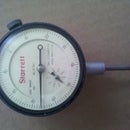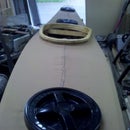Introduction: How to Fix a Lincoln MIG Welder That 'stutters'
A while back my handy little 110v MIG welder started to misbehave on me. The spark and wire feed would cut in and out in a strange sort of popping. At first I thought this was due to the wire getting stuck and the drive wheels slipping in the welder unit. This seemed to be confirmed because changing the way I draped the cable connecting the gun to the welder seemed to change how badly the welder acted up. Eventually I did a little investigating and discovered that the problem was actually in the trigger assembly of the gun/handle. Dis-asssembly and re-assembly are really easy, so before you spend $100 on a new gun, or several hundred on a new welder, why not give this a try.
Disclaimer:
This worked with my Lincoln 120Amp MIG welder, however, different models may have different designs, so take it slow, inspect everything, and think before you act.
Tools needed: none
cost: $0
Step 1: Safety
Unplug your welder. You should never perform any kind of work on your welder while the welder is plugged in. It's easy to get used to one of these little welders and forget that it is a really dangerous piece of equipment and should always be treated with caution.
Step 2: Open Up the Handle
Opening the handle: remove the collars at the top and bottom of the handle body by unscrewing them. In my case the collars are of the 1/4 turn to unlock, then pull straight off variety, rather than a standard nut (page 4 has a picture showing the mechanism). Go slowly; if you don't force anything you should be able to feel how the nut comes off with a little wiggling.
I recommend against using pliers since the parts are all plastic and easy to crush. If you need extra help I'd try wrapping the stubborn part in paper towel before gently using a set of channel lock pliers on it. DO NOT use any oil to loosen the parts. The switch mechanism relies on clean metal to metal contact, which most lubricants will prevent.
Once the collars are off the handle should separate easily into two halves. When you pull the halves apart the trigger will fall right out. It is spring loaded, so It may pop away from the handle a bit, so be ready for it.
Step 3: Inspect the Inside of Your Gun
On my gun, the trigger works by pushing a small copper ring up against two bare leads completing a circuit across them. I have the top half of the gun shell flipped upside down in my pictures, but the contacts are normally 1/4in (5mm) apart.
The bare contacts are normally pressed into little plastic slots which keep them aligned for the copper ring. If you look closely at the picture of the contacts, you will see that the top contact is not seated properly, and the contact tip is pushed down into the gun body. This was keeping that contact just on the edge of the copper trigger ring. This meant that, depending on how I held the gun, the contact might be made or stutter on and off. This little mis-alignment was the cause of all my problems. I suspect that the contact came loose when I accidentally banged the gun against something, and just kept working itself looser over time.
I corrected the problem by simply pushing the contact back into it's seat. You could probably add some glue if you wanted, but this fix was very easy, so I'm going to see if the problem happens again before taking that step.
Step 4: Re-seat the Trigger
place the trigger back into its housing. the little tabs sticking out at the front and back should fit easily into depressions in the gun body. There will be some compression of the spring so you may need to keep a finger on the trigger to get it to stay put. After you are sure that everything is aligned properly close the gun body back up.
Everything should go back together easily. If it feels like you need to apply any force there is something wrong, and you need to go back and check that everything is lined up properly. It can be a little tricky to hold the trigger in while you position the top half of the gun body, but mine only took a couple of tries before everything lined up nicely.
Then just keep the two halves held firmly together with one hand and screw the upper and lower collars back on with the other hand
Step 5: Finished
Your welding gun should be good to go now, grab a couple of scrap pieces of metal and test the gun out. If your welder still has problems at least you have eliminated the gun as a possible source.
Good luck and happy welding.












